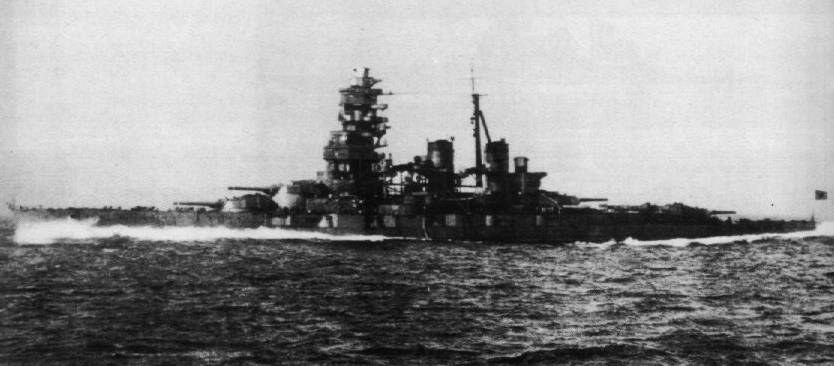Hi EJ,
This is truly fascinating work. Suffice to say I think you have demonstrated a strong correlation with CFD. I've only ever used ANSYS but I know we were always taught never to use the stuff by itself - but I suppose the scale-testing the RN did, those decades ago, probably still stands up by itself as covering the other side. Like you, I also wonder about the effects of a port turn and the non-linearities and periodic instabilities with seastate interference etc. Also, I gather that turning to port would have brought the portside trough further forward as the ship turned into it (she was obviously hit to Starboard - but I say this because am painting her from Port). While nobody could ever ever say it is absolutely the only correct theory that an enemy shell dived a short distance and struck below HOOD's 12" armour strake - the subject of understanding her wake patterns is fascinating by itself. Also illuminating to me because I am just putting the finishing touches on my painting of her, which I which I will post here in > 3weeks' time come May 24th.
Concerning theories as to how HOOD was lost - it also occurs to me that most of the conversations I am seeing are ignoring the fact that heavy shells don't always crash through ships in perfectly the same direction as their incident trajectory. Actually, there are some interesting accounts of shells impacting ships and deflecting at odd directions as they crashed through them - with one very notable story I think from HMS LION involving a shell eventually coming to rest between the legs of a poor terrified sailor (a stoker? I will have to re-check) somewhere deep within the ship. Must have given the poor guy a true fright.. but I shouldn't dive off on this tangent.. to quote a certain movie about something pertaining to gravity and black holes : "some things just weren't meant to be known".
At any rate I am impressed that you actually modelled where the peaks and troughs might be forming.. Regarding the below-attached I have built a grand total of three seascapes now, having experimented with these techniques for a little while; I usually just guess at this information with as much photo reference as I can find.. so there probably are some errors (although as you point out, water
is forgiving).. SO here's a nice little ad for Grandpa's Cabinets.. Ron Baluch made these oak trimmings for me. He's been a great guy to deal with.. the Prinz Eugen model is very old.. and needs its boot topping repainted higher.. and please don't get me started on my green HARUNA.. I realise that she possibly never painted up this way but this adult-sized kid has wanted one ever since his former child self first saw that very old (1970's) Fujimi boxart of the green leviathan with its anvil-shaped tophammer.. it is also very unlikely HARUNA could have actually made high speed by this stage of the war.. but I am just having fun.. actually.. all these ships can be removed from the seascapes and are not permanently attached to them anyway - so I may yet put an earlier KONGO into that one..
Hi Cag,
Thanks for your post.. I seem to recall that Admiral Holland had limited his formation speed to the maximum which PRINCE OF WALES could make, being circa ~29kts? HOOD had had machinery repairs by this point - and that stripped turbine blade having been fixed - and she probably might have achieved more - but POW was slower.. I will agree with you that true speed probably moved all over the show. At least the TWA was off to Starboard - so probably wouldn't have factored too much..
I do appreciate your input on flags however. Since we first started talking about this subject I have added a foremast Battle Ensign to PRINCE OF WALES (it's off in the distance, but still there) - and I will not be adding a second Ensign to HOOD, per FW Allen's advice regarding conversations he had had directly with Ted Briggs. My HOOD is just initiating her turn and is making the well-known "two-blue" signal on her Starboard lower signals yard.. I figure Starboard is a safe bet given that POW was in tow on her Starboard Quarter and Portside is leeward - with quite a mass of smoke obscuring any signal made from Port..
Fwiw I really appreciate having a 3rd party sanity check before I take the piece to the printmakers for proper scanning..
Hi Steve,
Those are lovely pictures of Sara (and Lex at the top? or just an older picture of Sara?) - thank you kindly for posting those. I will agree the flat surface makes the effect much easier to observe.. By the way we were in touch many years ago.. It is nice to see your business has evolved and grown. I picked up some parts from you last year which I really like..
But the other hullform coming to mind which makes a pretty big mine in the water is obviously that of the KONGOs.. this seems to be the most severe case of the effect I have ever seen (anybody is quite welcome to upstage me on this one though).. I mean, check out HIEI running speed trials..
Cheers, J

_________________
IG: @somewhere_east_of_suez
www.JosephReindler.com


